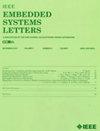No-Multiplication Deterministic Hyperdimensional Encoding for Resource-Constrained Devices
IF 1.7
4区 计算机科学
Q3 COMPUTER SCIENCE, HARDWARE & ARCHITECTURE
引用次数: 2
Abstract
Hyperdimensional vector processing is a nascent computing approach that mimics the brain structure and offers lightweight, robust, and efficient hardware solutions for different learning and cognitive tasks. For image recognition and classification, hyperdimensional computing (HDC) utilizes the intensity values of captured images and the positions of image pixels. Traditional HDC systems represent the intensity and positions with binary hypervectors of 1K–10K dimensions. The intensity hypervectors are cross-correlated for closer values and uncorrelated for distant values in the intensity range. The position hypervectors are pseudo-random binary vectors generated iteratively for the best classification performance. In this study, we propose a radically new approach for encoding image data in HDC systems. Position hypervectors are no longer needed by encoding pixel intensities using a deterministic approach based on quasi-random sequences. The proposed approach significantly reduces the number of operations by eliminating the position hypervectors and the multiplication operations in the HDC system. Additionally, we suggest a hybrid technique for generating hypervectors by combining two deterministic sequences, achieving higher classification accuracy. Our experimental results show up to资源受限设备的无乘法确定性超维编码
超维向量处理是一种新兴的计算方法,它模仿大脑结构,为不同的学习和认知任务提供轻量级、健壮和高效的硬件解决方案。HDC (hyperdimensional computing)用于图像识别和分类,利用捕获图像的强度值和图像像素的位置。传统的HDC系统用k - 10k维的二进制超向量表示强度和位置。在强度范围内,强度超向量对于较近的值是交叉相关的,对于较远的值是不相关的。位置超向量是为获得最佳分类性能而迭代生成的伪随机二值向量。在本研究中,我们提出了一种在HDC系统中编码图像数据的全新方法。使用基于准随机序列的确定性方法编码像素强度,不再需要位置超向量。该方法通过消除HDC系统中的位置超向量和乘法运算,显著减少了操作次数。此外,我们提出了一种混合技术,通过组合两个确定性序列来生成超向量,从而实现更高的分类精度。我们的实验结果表明,与传统超向量编码的基线HDC系统相比,运行时间减少了102倍,内存使用节省了显著的准确性。
本文章由计算机程序翻译,如有差异,请以英文原文为准。
求助全文
约1分钟内获得全文
求助全文
来源期刊

IEEE Embedded Systems Letters
Engineering-Control and Systems Engineering
CiteScore
3.30
自引率
0.00%
发文量
65
期刊介绍:
The IEEE Embedded Systems Letters (ESL), provides a forum for rapid dissemination of latest technical advances in embedded systems and related areas in embedded software. The emphasis is on models, methods, and tools that ensure secure, correct, efficient and robust design of embedded systems and their applications.
 求助内容:
求助内容: 应助结果提醒方式:
应助结果提醒方式:


